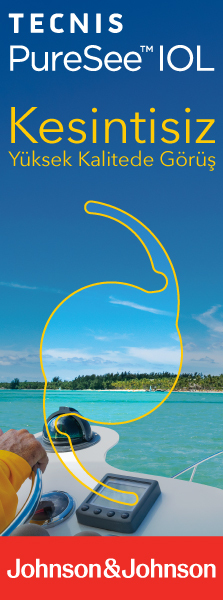TJ-CEO
2009 , Vol 4 , Num 3
Medical Treatment and Long Term Intraocular Pressure Fluctuations in Pseudoexfoliation Glaucoma
1S.B. Ankara Numune Eğitim ve Araştırma Hast., 1. Göz Kliniği, Ankara, Doç. Dr.2S.B. Ankara Numune Eğitim ve Araştırma Hast., 1. Göz Kliniği, Ankara, Asist. Dr.
3S.B. Ankara Numune Eğitim ve Araştırma Hast., 1. Göz Kliniği Şefi, Ankara, Uzm. Dr. Purpose: To compare the effects of different medical treatment options in terms of long term intraocular pressure (IOP) fluctuations in patients with pseudoexfoliation glaucoma (PXG).
Materials and Methods: Eighty-one eyes of 51 patients with PXG who have been treated in our clinic for at least one year (mean duration:18.6 months, range:12-55 months) with topical beta-blockers (BB), (betaxolol, timolol, or carteolol), carbonic anhydrase inhibitors (CAI), (brinzolamide, or dorzolamide), prostaglandin analogs (PGA), (latanoprost, or travoprost), or with their combinations were evaluated for pretreatment diurnal IOP, and post-treatment long term fluctuations (LTF) and changes in IOP.
Results: Twelve eyes were treated with BB, 20 with PGA, 12 with BB+CAI, 17 with BB+PGA, and 20 eyes were treated with triple combination (BB+CAI+PGA). Groups were lined up in terms of reduction rates in mean IOP as; BB< BB+CAI< PGA< triple combination< BB+PGA (15.0%, 21.4%, 24.2%, 30.0%, and 31.6%, respectively, p=0.041). Lining up in terms of reduction rates in maximum IOP was also found as BB< BB+CAI< PGA< triple combination< BB+PGA (14.9%, 22.8%, 25.9%, 29.6%, and 32.5%, respectively, p=0.050). No correlation existed between diurnal fluctuations and LTF (p=0.474), while significant correlations existed between LTF and both pretreatment and post-treatment maximum IOP levels (p=0.006, p<0.001). The sequence in terms of LTF range during treatment was as; BB< BB+PGA< PGA< BB+CAI< triple combination (3.5, 3.9, 4.0, 4.3, and 6.0 mmHg, respectively, p=0.215). LTF increased with the number of medications (p=0.012).
Conclusion: Long term IOP fluctuations in pseudoexfoliation glaucoma were found to be correlated with pretreatment IOP levels, rather than the medications or their combinations which were used. Keywords : Glaucoma, pseudoexfoliation, medical treatment, intraocular pressure, fluctuation





